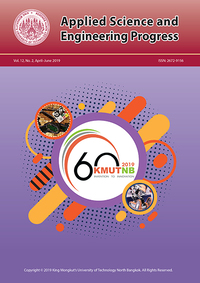Risk Rating of Precast Concrete Pile Fabrication Process: A Case Study in Bandung, Indonesia
Main Article Content
Abstract
The utilization of precast concrete pile has become prevalent in Indonesian construction industry. The business process within the fabricator of precast concrete pile includes fabrication and installation process. This study is intended to fill research gap in fabrication process since most of the risk studies focus on the installation process. This study is aimed to identify and rate all risks related to the precast concrete pile fabrication process, followed by a recommendation of mitigation strategy. The preliminary risks are identified through field observation to a precast concrete pile fabricator in Bandung, Indonesia. The preliminary risks are validated using Delphi technique, resulting 22 final risk factors. The final risk factors are rated using risk matrix method. The high and medium category of the rated risks are sling failure; bar-cutter and/or bar-bender machine failure; hoist crane failure; and pile chip defect. Since most of those risks occur on the respective machine, the general mitigation strategies are to provide a backup machine and the frequent monitoring and maintenance. Besides, an adequate standard operation procedure of each fabrication stages needs to be established and its implementation should be monitored carefully.
Article Details
References
[2] M. M. Riza. (2011, May). Pondasi Tiang Pancang (Pile Cap Foundation). ARS Group, Bellevue, USA [Online]. Available: http://www.perencanaanstruktur.com/2011/05/seluk-belukpondasi-tiang-pancang.html
[3] KITASIPIL. (2017, Apr.). Mengenal Pekerjaan Tiang Pancang (Pile). KITASIPIL, Bellevue, USA [Online]. Available: http://www.kitasipil.com/2017/04/mengenal-pekerjaan-tiang-pancangpile.html
[4] Federation of Piling Specialists. (2010, Jul.). Examples of Hazards associated with Piling and Diaphragm Walling Works and how these might be managed within the design phase of a project (neither exhaustive nor exclusive). Federation of Piling Specialists, London, England [Online]. Available: https://www.fps.org.uk/content/uploads/2017/05/SID-Examples-of-Piling-Hazards-and-Risks.pdf
[5] T. Bles, S. Al-Jibouri, and J. V. D. Adel, “A risk model for pile foundations,” presented at the 20th International Symposium on Automation and Robotics in Construction ISARC 2003 The Future Site, Eindhoven, Sep. 21–23, 2003.
[6] A. G. Gibb, R. Haslam, T. C. Pavitt, and K. Horne, “Designing for health – reducing occupational health risks in bored pile operations,” Construction Information Quarterly, Special Issue: Health and Safety, vol. 9, no. 3, pp. 113–123, 2007.
[7] T. M. Zayed and D. W. Halpin, “Pile construction productivity assessment,” Journal of Construction Engineering and Management, vol. 131, no. 6, pp. 705–714, 2005.
[8] L. K. Putri and I. W. Suletra, “Analisis risiko K3 di proses produksi tiang pancang dengan metode JSA dan risk matrix: Studi kasus di PT X,” presented at the Seminar dan Konferensi Nasional IDEC 2017, Surakarta, May 8–9, 2017.
[9] A. P. C. Chan, E. H. K. Yung, P. T. I. Lam, C. M. Tam, and S. O. Cheung, “Application of delphi method in selection of procurement system for construction projects,” Construction Management and Economics, vol. 19, no. 7, pp. 699–718, 2001.
[10] A. B. Renzi and S. Freitas, “The delphi method for future scenarios construction,” Procedia Manufacturing, vol. 3, pp. 5785–5791, 2015.
[11] I. A. Kıral, Z. Kural, and S. Çomu, “Risk identification in construction projects: Using the delphi method,” presented at the 11th International Congress on Advances in Civil Engineering, Istanbul, Turkey, Oct. 21–25, 2014.
[12] E. E. Ameyaw, Y. Hu, M. Shan, A. P. C. Chan, and L. E. Yun, “Application of delphi method in construction engineering and management research: A quantitative perspective,” Journal of Civil Engineering and Management, vol. 22, no. 8, pp. 991–1000, 2016.
[13] S. More and T. Hirlekar, “Effectiveness of risk management and chosen methods in construction sector,” International Research Journal of Engineering and Technology, vol. 4, no. 11, pp. 2006–2009, 2017.
[14] A. Sourani and M. Sohail, “The delphi method: Review and use in construction management research,” International Journal of Construction Education and Research, vol. 11, no. 1, pp. 54–76, 2015.
[15] M. Abdelgawad and A. R. Fayek, “Risk management in the construction industry using combined Fuzze FMEA and Fuzzy AHP,” Journal of Construction Engineering and Management, vol. 136, pp. 1028–1036, 2010.
[16] D. Baloi, “Risk analysis techniques in construction engineering projects,” Journal of Risk Analysis and Crisis Response, vol. 2, no. 2, pp. 1–9, 2012.
[17] S. M. Renuka, C. Umarani, and S. Kamal, “A review on critical risk factors in the life cycle of construction projects,” Journal of Civil Engineering Research, vol. 4, no. 2A, pp. 31–36, 2014.
[18] K. Mhetre, B. A. Konnur, and A. B. Landage, “Risk management in construction industry,” International Journal of Engineering Research, vol. 5, no. 1, pp. 153–155, 2016.
[19] D. H. Stamatis, Failure Mode and Effect Analysis. Wisconsin: ASQ, 2003.
[20] S. Mortimer and D. Mortimer, Quality and Risk Management Tools. Cambridge, England: Cambridge University Press, 2015.


